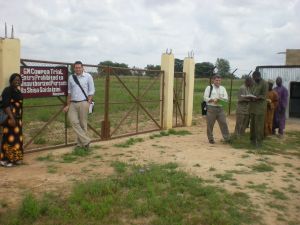
Farmers around the world are using innovations in plant science to increase crop yields, improve sustainability and combat food insecurity. For example, Nigerian farmers are now planting genetically modified (GM) cowpeas that resist their greatest insect pest. This has the potential to increase yields by as much as 80 percent!
In December 2019, the government of Nigeria approved this GM cowpea, which was developed by Nigeria’s Institute for Agricultural Research at Ahmadu Bello University in Zaria in collaboration with American and Australian researchers. After decades of research, Nigeria’s farmers are now growing the new variety of this staple legume that will help millions combat hunger and poverty.
Cowpeas, known as black-eyed peas in many countries, are threatened by the Maruca vitrata pod borer, which can destroy up to 80 percent of a crop. The GM variety is resistant to this insect, allowing farmers to significantly reduce crop losses as well as improve food security and their livelihoods.
We talked to CropLife International’s (CLI’s) Dr. John McMurdy (JM), vice president of innovation and development, and the African Agricultural Technology Foundation’s Dr. Emmanuel Okogbenin (EO), director of programs and commercialization, about the benefits of this innovation and how it came about.
CLI: I understand that you have some history with the GM cowpea. Can you tell me about your background with this project?
JM: Of all the biotech research and development (R&D) work happening, this one is probably closest to my heart. I started my plant biotech career in 2009 at the U.S. Agency for International Development (USAID), working in the office that managed grants for supporting agricultural R&D, including grants related to biotechnology and food security-focused crops that hadn’t gotten a lot of attention from private industry at that time. One of those grants was this very same insect-resistant cowpea project. The research had been going on for a few years at that point and was being managed by the African Agricultural Technology Foundation along with many other partners.
On an even more personal level, my first trip to Africa was to Nigeria for a site visit for this project. I travelled to a town called Zaria in the north of the country, where most of the GM insect-resistant cowpea fieldwork was happening. I still have a picture from this trip in my office. It always has a fond spot in my heart. While the project wasn’t brand new at that time, it was still in an early phase. Seeing it now in the hands of cowpea farmers gives me much joy.
CLI: What is the science behind the GM cowpea? What makes it different than the conventional variety?
OE: M. vitrata, known as the bean or legume pod borer, is among the major insect pests of cowpea. Yield losses due to this pod borer range from 20 to 80 percent, depending on the level of infestation. There are no known cowpea varieties resistant to the insect; hence, farmers regularly spray chemical insecticides five to eight times within a season to control this and other insect pests. This practice is neither sustainable nor environmentally friendly for smallholder farmers in Africa. The inability to control the pod borer is a serious challenge to the production of cowpea as an important food crop. The Bacillus thuringiensis (Bt) biotech trait is highly effective in controlling this pest.
When the pod borer ingests the GM cowpea, the Bt toxin dissolves in the high pH of the insect gut and becomes active. The toxin then attacks the gut of the insect, punching holes in the lining and causing death. The GM cowpea has led to reduced reliance on the use of pesticides from 5-8 times to only two sprays per season, improving product safety for farmers and consumers as well as providing higher yields as there are more pods to harvest. There is no difference between GM and conventional cowpeas other than the built-in Bt resistance gene against the pod borer.
CLI: How important is the cowpea to the local diet? What does approval of the GM variety mean for farmers and consumers?
OE: Cowpea is an important, staple legume in the diet of more than 200 million people in sub-Saharan Africa. Its protein-rich seeds provide valuable nutrition to people, including babies. Unlike many other legumes, cowpea’s green leaves and immature pods are also edible as vegetables and they are rich in vitamins and minerals. Cowpea is referred to as “poor man’s meat” in some parts of the continent as it is a substitute for animal proteins. It is used to produce a lot of local delicacies such as akara (fritters), moi-moi (steamed bean pudding) and porridges.
The environmental and commercial release of the GM cowpea by the Nigerian government has put a smile on the face of farmers who normally spend a high amount of money on insecticides to control the pod borer. Increased productivity will increase household income as there will be enough cowpeas for selling and it will improve local sourcing to meet high internal demand. Nigeria is currently the largest importer of cowpeas because of its population size. The GM cowpea will revamp this market. Moreover, the reduced use of insecticides will be good for the environment and farmers’ health. It may also lower production costs and consumer prices.
CLI: What has been the process and timeline to get this crop approved and seeds into farmers’ hands?
JM: I wish I could say it had been an efficient timeline, but it has taken quite a while for many reasons. This project launched in the early 2000s. At that time, R&D institutions were exploring the use of genetic modification in crops that could have a significant impact in developing countries. The biotech trait used in GM cowpea had already been used in corn for several years but bringing it into a crop like cowpea was new.
The first actual field trial work in Nigeria happened around 2007. There wasn’t any familiarity with biotech crops in Nigeria – like much of the global south – at that time. In addition to the lack of practical experience by research institutions, there wasn’t a policy mechanism that could concurrently approve their use for commercial purposes. So, policy and biosafety development occurred at the same time as technology transfer and capacity-building. Overall, the timeline was about 20 years from conception to getting in farmers’ hands thanks to the long-term commitment of the partners, Nigerian government and donors.
Since the cowpea project has been active in Nigeria, several other biotech crops have been under development, including rice, corn, cotton and sweet potato. But the cowpea project was one of the first and a flagship.
CLI: What are the benefits of GM cowpeas? How do they help fight food insecurity?
OE: The benefits of GM cowpea include increased yield, income for farmers and improved nutrition for households. It also benefits the environment by reducing the number of insecticide sprays from 6-10 times to just two in a cropping season. In addition, GM cowpea is resistant to highly damaging parasitic weeds.
These benefits allow this crop to improve food security through better performance and improved productivity. Its wide cultivation from high adoption will increase resilience of food systems and support environmentally friendly agricultural practices. This will lead to increased income for smallholder farmers and access to cowpea international trade.
CLI: What have been some of the biggest challenges in getting this product to market? Why has it taken so long?
JM: It’s been a combination of things. For example, there weren’t any regulations or policy systems in place to facilitate the introduction of biotech products. Given that Nigeria is a signatory to the Cartagena Protocol on Biosafety, there was some requirement that they have such systems in place. The timing of building the policy system no doubt impacted the cowpea technology. Today, Nigeria is one of the undoubted leaders in developing and implementing biosafety policy.
Another challenge was misinformation that delayed and even aborted the introduction of biotech products all over the world in the past 25 years. Nigeria’s – and most of Africa’s – largest trading partner is Europe, and the impact of EU policy cannot be understated. Further, much of the anti-GMO sentiment around plant biotech products originated in Europe and continues to be reinforced by EU institutions. So, in addition to the lack of a proper policy environment in Nigeria, societal distrust was seeded into its communities.
Third, there was considerable time involved in the technology development process. Cowpea isn’t a major crop of interest to the private sector. But Nigeria produces more cowpeas than any other country in the world and even so, it imports 20 percent of the cowpeas it consumes. Given that the GM cowpea project started from a proof-of-concept phase, significant time and effort were spent validating its performance locally before commercialization.
CLI: How does the GM cowpea help smallholder farmers be more sustainable?
JM: The real value of this insect-resistant cowpea is that it specifically targets M. vitrata pod borers. These pests are a massive economic and food security threat to Nigerian growers who depend on cowpeas for income. The ability to preserve more of that yield using this nature-based technology is a huge benefit for farmers, allowing them to optimize inputs and production. Nigeria is the world’s largest consumer of cowpeas by far. If it can’t meet its own demands for the crop, it must either put more land under cultivation or purchase cowpeas from the West African market. Getting more productivity out of existing land helps us collectively conserve land and biodiversity.
Cowpea farmers in Nigeria have been aware of this technology for a while now. They’ve seen demonstration plots and side-by-side images comparing Bt cowpeas to conventional; it’s drastic. They know what GM cowpeas can do for them and some of the early adopters are very excited to now have it in their fields. Thank goodness, the long wait is over.
OE: GM cowpeas have reduced the cost of production and improved yield, nutrition and income for smallholder farmers. This technology is more sustainable and environmentally friendly with good stewardship that should support its long-term usage. Increased cowpea production will strengthen food systems and alleviate hunger and poverty for smallholder farmers.
CLI: Who else has been involved in making the GM cowpea happen? Which partnerships and collaborations have been involved?
JM: At the outset, there was a consortium of individuals and institutions that had the idea to take the Bt insect resistance trait used in corn and move it into cowpea. They included breeders and entomologists at Purdue University in Indiana, USA, led by Dr. Larry Murdock. Another key individual was Dr. T.J. Higgins, a legendary cowpea breeder at CSIRO research institute in Australia, who led the genetic transformation efforts.
Leading the eventual implementation of the project in Africa was the newly formed African Agricultural Technology Foundation (AATF) at that time. It facilitated intellectual property transfer and the on-the-ground team was led by Dr. Mohammed Ishiyaku of Ahmadu Bello University. In addition, Monsanto (now Bayer) donated the technology without any licensing fees or royalties. The USAID was also involved, funding a lot of the work.
CLI: What has been the reaction from farmers and others on the ground in Nigeria to this new innovation?
OE: Farmers are very happy about the product. The demand for GM cowpea seed is very high; certified seeds produced to kickstart commercialization in Nigeria sold out immediately. It is a new dawn for cowpea farmers. The project is rapidly ramping up seeds to meet demand.
CLI: What are the takeaways from GM cowpea development and ways to improve the biotech crop approval process?
JM: One of the top takeaways is that even though there was a longstanding and sustained commitment of partners, it was not a quick success. Its incremental progress will hopefully lead to significant success in the end. Such sustained commitment is essential along with strong, committed local partners, including the national government.
Another big takeaway is about the policy environment and the way decisions are made on biotech products. Over 20 years, there was an opportunity to ask any possible question about the biotech cowpea. It makes sense to streamline that process and focus on key pieces of information actually needed to make regulatory decisions.
CLI: What’s next for the spread of modern innovation across Africa?
JM: In the past 6-7 years, there has been more movement towards the adoption of plant biotech products and other seed innovations in Africa than anywhere else. It’s been primarily led by demand and interest in GM cotton varieties that have been able to bolster and strengthen the textile industry. There are six to seven countries now commercially growing Bt cotton. In the past three years, there has also been movement towards the approval and commercialization of other directly consumed food crops like maize and cassava.
There is also a lot of interest on the continent around genome editing, the next iteration in innovation and plant breeding. Rather than bringing in whole genes, this process allows edits to be made directly to a plant’s native genome. Significant R&D is happening on genome-edited products right now, especially in parts of East Africa. This will be another opportunity for innovation.
CLI: Is there anything else that you would like to add?
OE: Putting pod borer resistance into cowpea varieties in Nigeria is ongoing. This work is being replicated in Ghana and Burkina.
JM: This is an example of a publicly led effort delivering a technology to solve a massive problem in an underdeveloped market. I hope we are going to see a rapid increase in adoption and utilization of the GM cowpea in Nigeria and that neighboring countries learn what value it can deliver.
CREDIT: This article was originally written for CropLife International




















































































